Coupon marketing (or coupon advertising) is a promotional strategy that incentivizes customers to redeem coupons in order to increase sales of your products or services. We explain the ins and outs of building a coupon marketing strategy and improving campaigns below. Keep reading to find out if it’s a good fit for your business and how to implement it.
What Coupon Marketing Is
Coupon marketing is a promotional strategy that relies on discount codes or other incentives to encourage purchases. There are two main types of this type of marketing: print and digital. Digital coupons have a much more expansive reach online and have definitely caught people’s attention. However, the numbers show that traditional coupons are redeemed more.
In addition to increasing sales, here are some of the other benefits of incorporating a coupon marketing strategy in your business:
- Attract new customers with enticing discount deals.
- Promote brand awareness by making your coupons recognizable and on-brand.
- Drive website traffic by sharing coupons through ads, social media, and email blasts.
- Incentivize customer loyalty and reward repeat customers to show appreciation.
- Track the success of marketing campaigns by assigning unique codes and creating landing pages for each campaign, then analyzing redemption rates.
- Gather valuable customer data by offering coupons in exchange for emails or other information.
Want to really make an impact? Use both digital and printed coupons to reach different audiences. Get inspired on ways to do both in our list of dozens of coupon examples and ideas.
How to Develop a Coupon Marketing Program
1. Determine Your Goals
Coupon ads can be used for a number of other purposes. For example, using an exit-intent pop-up coupon can decrease abandoned carts and potentially save a lot of lost revenue. Exit-intent pop-ups usually convert around 15%, especially if you turn off the email capture.
Other common coupon advertising objectives include:
- Building brand discovery
- Triggering impulse purchases
- Staying top-of-mind (reminder advertising)
- Generating loyalty and improving retention rates
- Increasing purchase and return visit frequency
- Incentivizing an action, such as a review
2. Establish a Coupon Marketing Strategy
Once you have identified your goals, you can then define your coupon marketing strategy. This involves choosing which of the various types of coupons, which include print coupons, digital coupons, or discount codes, will best support meeting your goal.
For example, a business trying to increase email campaign open rates as a goal might adopt a digital coupon strategy to incentivize their target audience and increase conversion rates. This strategy works well for this goal because 81% of online shoppers enjoy getting emails announcing promos and other discount offers.
Each type has its benefits and drawbacks. Here’s a quick comparison of physical versus digital coupons:
Print Coupons | Digital Coupons |
|---|---|
Pros
| Pros
|
Cons
| Cons
|
If you plan on offering more than one type of coupon as part of your marketing strategy, add a unique promotional code on each coupon type. This will help you identify which coupons are converting best. Voucherify has a free tool that lets you create personalized coupon promo codes that feature unique number/letter series that can then be printed on whatever coupon type works best for your marketing strategy.
3. Strategize Your Design
According to Statista, 89% of Millennial consumers would try a new brand if they were offered a coupon or discount. However, the best-performing coupons feature several key components in their design besides offering value to the consumer.
There are three main components of a successful coupon:
Eye-catching Visuals
Coupons depend on people seeing them, and in a noisy world flooded with adverts and stimuli coming from every direction, you need to create an eye-catching and visually appealing coupon. In many cases, it’s worth it to hire a graphic designer to ensure your coupon does just this.
Clear Message
On top of looking good, just like any other type of marketing materials, coupons also need great copy. It’s crucial to have one clear marketing message. In short, people need to be able to quickly understand what your coupon is offering at a glance.
Single Call to Action
OK, you’ve been reeling your audience in, and now it’s time to seal the deal. Include a call to action (CTA) to get people to take the next step, whether that’s a live link to the product you’re promoting for a digital coupon, a coupon code, or directions to show the ad to a cashier the next time they visit your business.
When designing your coupon, put your target audience first. Think about which coupon distribution method (e.g., email, Groupon, website pop-up, social network, etc.) will best reach them, how your coupon’s design can stand out in said distribution channel, what offer would be most compelling, and what would get them to take advantage of your offer.
4. Execute & Tweak the Design
A well-designed coupon can make or break your campaign. Depending on your advertising experience and resources, you will ultimately choose to design the coupon in-house or outsource to the pros.
If you or your team have design experience, then designing coupons on your own will be the obvious choice. If not, or if you’re not overly confident in your own graphic design abilities, hire a freelancer or use a design platform to be sure.
Here are some popular free and inexpensive sources for professional coupon design:
Do-it-yourself (DIY) graphic design platform | Low-cost freelance marketplace | Premade postcard coupon templates and design tools |
Hundreds of free templates, images, fonts, and icons | Thousands of graphic designers to choose from | Design, print, and mail out coupons in minutes |
Starting cost: Free | Starting cost: $5 | Starting cost: $329.99 to print and mail 100 postcards |
Looking for more options? Our list of the best places to get free images for website design includes many cheap and free options for templates, images, and designing coupons online.
5. Plan Distribution & Coupon Advertisement
The best place for distributing your coupon will depend largely on the type of business you run, your audience, your advertising objective, and your overall coupon marketing strategy. As with any form of advertising, you want to choose the distribution channel that best aligns with your target audience and your advertising goal or objective.
It may also be worthwhile to use more than one distribution channel for more ad exposure. For example, if you’re promoting your ad to serve as reminder advertising to an existing customer base, promote your coupon to your social followers and via email.
Keep in mind that no matter where you choose to distribute your coupons, there needs to be timeliness, relevance, and perceived value in every offer to maximize exposure and boost customer follow-through.
There are several options when it comes to distributing print or digital coupons to promote your small business. The most common are:
Coupons displayed in pop-up boxes on small business websites convert browsers into buyers by giving site visitors a reason to make a purchase immediately to take advantage of a limited-time offer. They are often deployed when a visitor appears to be leaving a product page or to reduce shopping cart abandonment. Businesses see a lot of success with this strategy—some report as much as a 2x sales conversion rate from using exit-intent pop-up coupons on their website, for example.
Similar to pop-up boxes, website splash pages are commonly used to extend discount codes to site visitors. But while pop-ups appear when someone is leaving, splash pages are introductory pages site visitors need to navigate to get to other content. They’re commonly used to promote sign-ups to email and text marketing lists and usually extend a special offer for a percentage off the first purchase.
If your business has a mobile app, you may be able to display digital coupons to your audience in multiple ways. These include app pop-ups and splash pages, push notifications, and text or email marketing.
Coupon books can be distributed through direct mail, at events, or given away as part of a customer loyalty program. Coupon books are also great for building brand awareness, especially in local communities.
Coupons sent via email marketing can be used to generate new business, reconnect with lapsed customers, incentivize repeat business, or reward customer loyalty. In fact, 45% of consumers want to get promotions for food and groceries via email. If you go this route, make your life easy and use one of the best email marketing platforms to automate and track performance.
Coupons can be used to drive traffic to dedicated landing pages, however, they are also effective in converting site visitors. For example, if you run Google Ads to promote your business, adding a coupon to your ad’s landing page can increase conversions and speed up buying decisions. Check out our list of the best landing page examples and find out more about how to increase conversions.
Print coupons have been widely used since Coca-Cola issued the first coupon in 1887 and, yes, newspapers are still used to distribute coupon advertisements today. Newspapers provide local businesses with a great way of reaching customers in their area through coupon advertising. Learn more about newspaper ad costs and what factors are involved.
Direct mail is another classic coupon marketing strategy. For example, postcards are a great medium to deliver coupon ads that are cost-effective and eye-catching. Get instant pricing for your postcard specs by visiting VistaPrint, or for more information, check out our article on direct mail marketing ideas.
Of course, every business with a physical location—or selling products in one—should also consider coupons as part of its overall retail promotion ideas. This can include anything from adding coupons to incentivize return visits on receipts to coupons on product packaging (e.g., the $1 off sticker or tag on grocery store products) meant to increase immediate sales.
6. Place on Coupon Websites
If you’re looking to build brand visibility, consider using a coupon site like Groupon or LivingSocial. People are visiting these platforms—18.2 million on Groupon alone—to find deals from businesses and brands they’ve never heard of. In fact, coupon sites are commonly used for local advertising as they give businesses like restaurants and salons an easy way to attract new customers in a short period of time.
Here’s an overview of some of the most popular coupon websites to consider:
Best for: Incentivizing purchases with a cashback reward
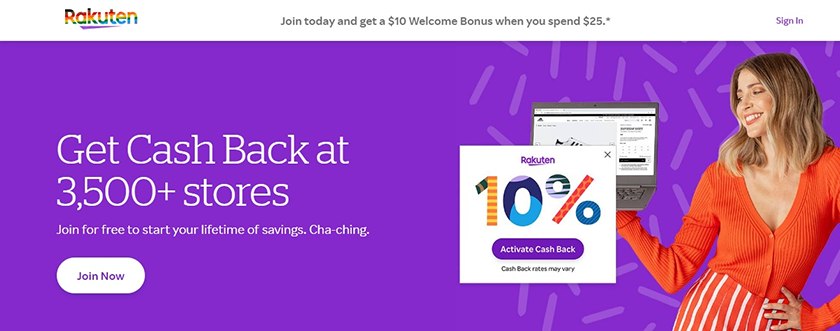
Rakuten is a well-known cashback marketplace. (Source: Rakuten)
Rakuten is a great way for businesses to sell coupons with cashback offers. It’s one of the world’s largest online marketplaces, which makes it a great way to get your business in front of a large audience and increase traffic to your website. When you create a coupon campaign on Rakuten, you can embed it on your website or promote it through Rakuten’s social media channels.
Best for: Getting actionable data from customers
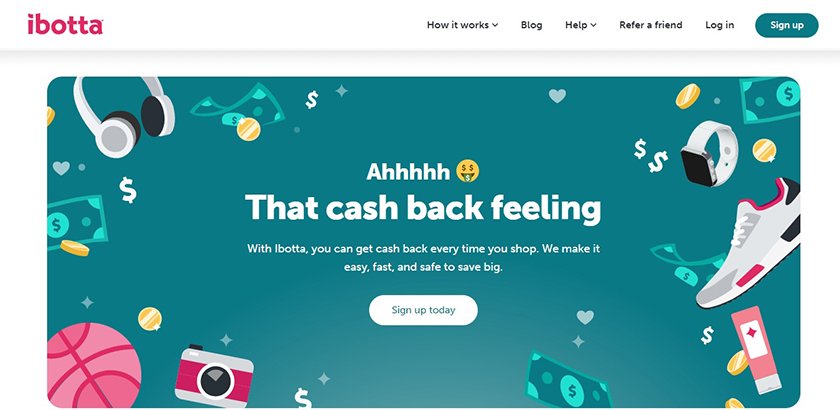
Ibotta is used for earning cashback coupons through engagement. (Source: Ibotta)
Ibotta has a powerful redemption engine. When a customer redeems a coupon from a business, it is automatically shared with that business’ social media followers. This helps to drive traffic back to the business’ website or storefront. Customers get paid based on their level of engagement while retailers gain customer insights that can help them bolster their sales.
Best for: Getting feedback from consumers through paid surveys
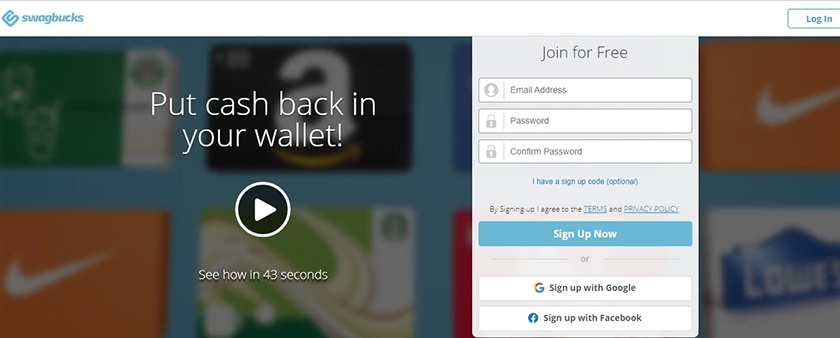
Swagbucks allows customers to earn points and coupons by performing actions. (Source: Swagbucks)
Swagbucks allows businesses to sell coupons to their customers to drive traffic back to their website and increase sales. It also offers a wide variety of ways to promote coupons, including emails, social media, and even printable coupons.
Swagbucks members earn points (called SB) for things they are already doing online, like taking surveys, watching videos, and shopping. Members can then redeem those SB for free gift cards to places like Amazon, Walmart, and Starbucks.
Best for: Introducing a brand or its products or services to new customers
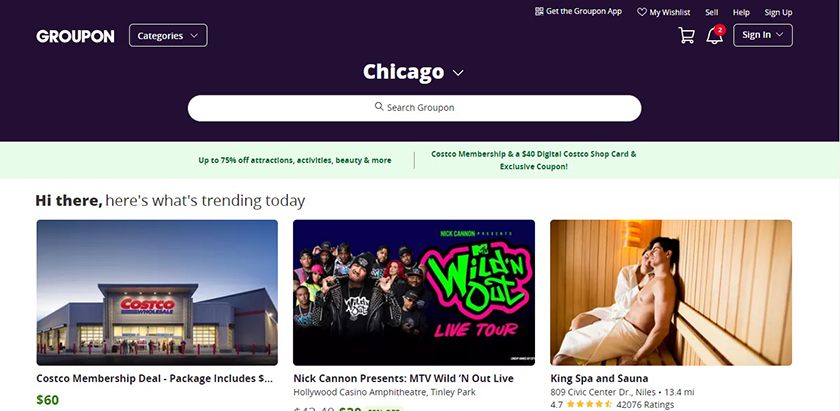
Groupon’s online coupon marketing strategy relies on compiling discounts from different businesses. (Source: Groupon)
Groupon is a coupon website brands can use to sell products or services at a discount. Items are purchased on Groupon (and Groupon receives a share of the revenue) and the purchaser can then proceed to the business to get the item or enjoy the service they bought.
It’s an effective way to attract new customers; however, deep discounts have been known to attract one-time deal seekers more so than loyal customers. So if you choose to extend a Groupon offer, make sure you have a plan to turn the new customer into a repeat customer, such as ensuring they sign up for more offers via your email marketing newsletters.
Best for: Attracting customers looking for active deals on products or services they want to buy
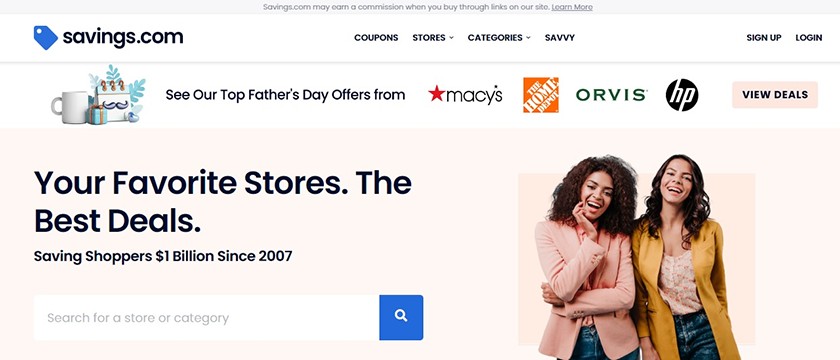
Savings.com features coupons from popular businesses and more. (Source: Savings.com)
Savings.com is a great resource for businesses to sell coupons and discounts. The website offers an easy-to-use platform for businesses to post their deals, as well as a variety of promotional tools to help drive traffic to their deals.
Savings.com also has a large audience of consumers who are actively looking for deals on the products and services they need. The website receives hundreds of thousands of visits per month.
Best for: Connecting with new customers through corporate social responsibility
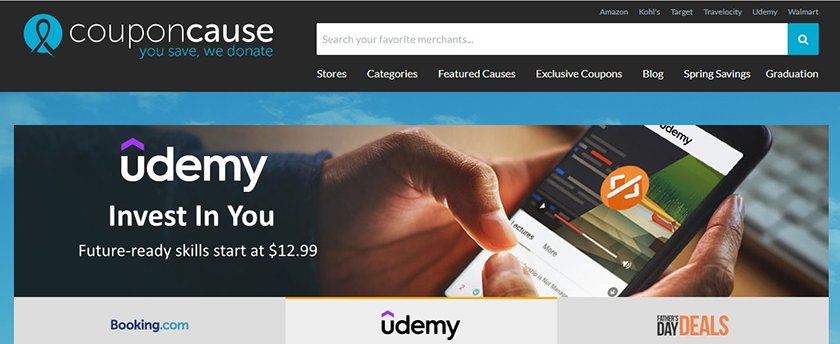
Aside from offering discounts, CouponCause donates to a cause of the business’ choice. (Source: CouponCause)
CouponCause is the only coupon platform that donates a percentage of every sale to a charity of the business’ choice. Businesses can feel good about themselves for running a coupon campaign because they are also donating to a good cause. CouponCause also has an extensive and engaged user base. When businesses run a coupon campaign on CouponCause, they reach out to millions of potential customers.
How to Analyze Performance & Improve Campaigns
To ensure your campaigns are performing well, you need to be able to track each coupon’s performance. This activity helps you examine which part of the campaign is helping boost your sales and the aspects that are not performing as expected so that you can adjust spending accordingly.
To analyze the performance of your coupon marketing strategy and improve campaigns:
- Identify how many products/services were sold throughout the campaign.
- Compare the profits gained with the planned results.
- Monitor and compare budgeted vs actual costs.
- Leverage various tools to automatically analyze customer demographics.
- Use demographic data to identify your target consumers and create coupons that appeal specifically to them.
- Based on the campaign data, assess if your offer is compelling enough for your target audience.
- Based on your campaign tracking, assess if your chosen marketing channels were effective enough.
How to Improve Coupon Redemption Rates
If you’re still low on ideas on how to make your coupons more compelling and effective, try out these discount marketing strategies that are commonly used in the industry:
- Align timing with an event: Running relevant holiday promotions is a good business move. People love a good holiday sale, no matter when it is. Keep an eye on upcoming events and create a coupon code to send out during those celebrations. Take advantage of the opportunities to run holiday promotions your customers will look forward to year after year.
- Create a sense of urgency: To incite action, coupons are meant to be a short-term offer—otherwise, they would just be a pricing strategy, not a form of advertising. There are two main ways to create a sense of urgency, either by offering the coupon for a limited time or offering a certain number of coupons.
- Suggest exclusivity: In addition to scarcity, exclusivity is another common component in coupon advertising. For example, a business may offer special coupons to its followers or loyalty program members to make others want to become followers or members.
How to Know If Coupon Marketing Is Right for Your Business
The main aim of marketing coupons is to increase sales and attract new customers. But there are both pros and cons to using coupons as a marketing strategy.
| PROS | CONS |
|---|---|
| Low-cost form of advertising | Customers may associate your product or service’s value with its sales price |
| Proven tactic for attracting new customers, getting return visits, and building subscriber lists | If your only selling point is the lowest price, you’re unlikely to generate long-term sales |
| Reduces abandoned cart rates | Discount-driven new customers may not return |
| Builds brand loyalty and incentivizes repeat purchases | |
Coupon marketing allows businesses to distribute coupons to potential and current customers to entice them into buying a product or service. It is a great way to drive traffic and sales to your small business, build customer loyalty, and generate both new and repeat business. But not every business is a good fit for coupon marketing.
Relying too heavily on discount coupons could backfire since it can potentially affect your brand by making it look cheap and less desirable. You also have to consider your target audience and their motivations as well as their stages in the buying cycle.
To determine if coupon sales promotion is right for your business, ask yourself these questions:
- Would a coupon make someone more likely to buy my product or service?
- Do I have a good offer that’s worth a coupon?
- Can I generate enough traffic with coupons to make it worth my time?
- Do I have the resources or tools needed for customers to redeem coupons?
- Do I have the ability to track redeemed coupons?
- Does extending coupons or discount codes diminish the perceived value of my product or service?
Coupon Marketing Statistics for Small Businesses
Coupon marketing is a cost-effective way for small businesses to drive traffic and sales. In fact, according to data provided by Statista, roughly 90% of American consumers use coupons for shopping. Here are the top coupon statistics to keep in mind to learn more about consumer behavior and see how this industry has evolved over the years:
- Rakuten was the most popular coupon website in April 2023, followed by SlickDeals and Capital One Shopping.
- Statista found that over 337 million digital coupons were redeemed in the U.S. in 2021.
- In 2022, Insider Intelligence reported that more than 90% redeemed their digital coupons via smartphone.
- The top social platform used to find coupons in the U.S. is Facebook, which is used by 42% of customers.
- Business owners should consider creating more coupon advertisements because online shoppers who use coupon codes are projected to spend 24% more than other shoppers.
- Data from Airship found that 79% of U.S. adults use smartphones while shopping in-store to access loyalty cards or coupons.
- Due to recent inflation, 42% of U.S. adults say they’re likely to buy brands that are on sale and 33% say they’re likely to wait to buy items only when they are on sale.
Frequently Asked Questions (FAQs)
Encourage more customers to use your coupons by making them easy to find on your website and social media pages. Email your customers about new coupons and discounts, or post them on your blog or in your store. Make sure to offer bonus points or rewards for customers who use your coupons.
Facebook business pages have a ton of features and capabilities, one of which is to create a coupon or discount that can be shared with your followers. To do this, log in to Facebook and navigate to Ads Manager. Then, begin creating a new ad, and when you find the section labeled “Offer,” switch the toggle button on.
Coupon marketing attracts new customers by incentivizing them to try your business. Offering promotions or discounts at strategic moments can dramatically increase conversions. They can also be used with referral lead generation as part of your overall marketing strategy. For example, service-based businesses like salons often extend a new client coupon with a matching or comparable reward for the referring client.
Bottom Line
Any brand can use coupons as a small business marketing idea for growing sales and gaining new customers. Success will depend on the quality of your campaign, its timing, and the extent to which you can get customers to redeem your coupons.
The best way to get your coupons into the hands of your target audience locally is through a direct mail service like VistaPrint. You can design, print, order, and send your coupons out in minutes at an affordable price.
Two of the top reasons people follow brands on social media are to learn about new products and get special offers. So share your coupons and discount codes on your Facebook Business Page, in Facebook Groups, on Twitter, Instagram, and the other social platforms you use. You can include them in organic posts, but distributing them via social media ads is the best way to get them into the hands of your ideal customers using advanced audience targeting.